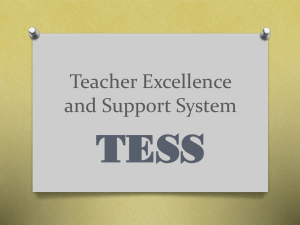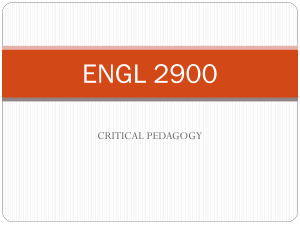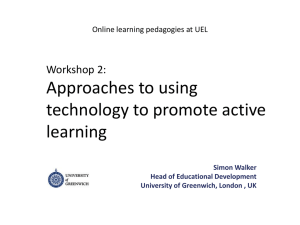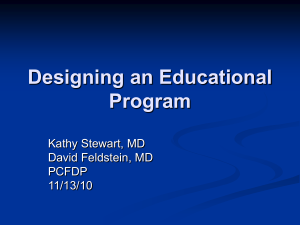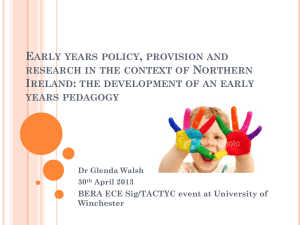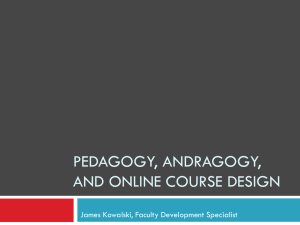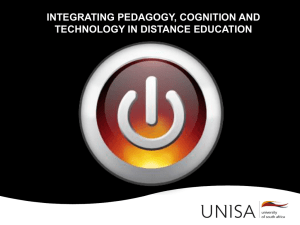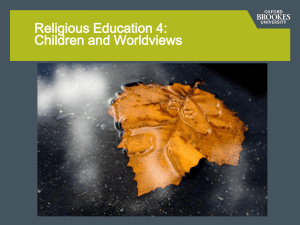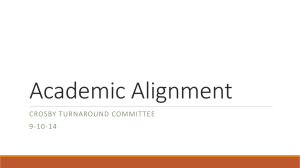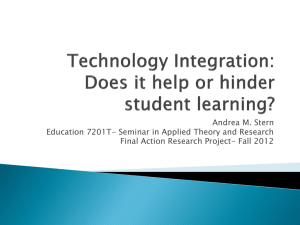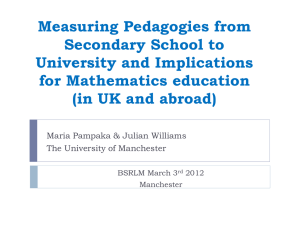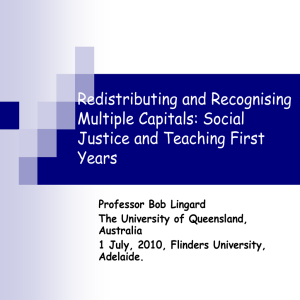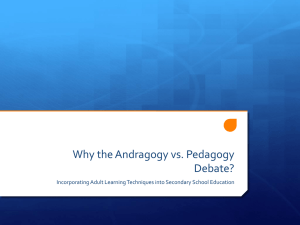Teaching Quality is the Big Factor in Student Learning
advertisement
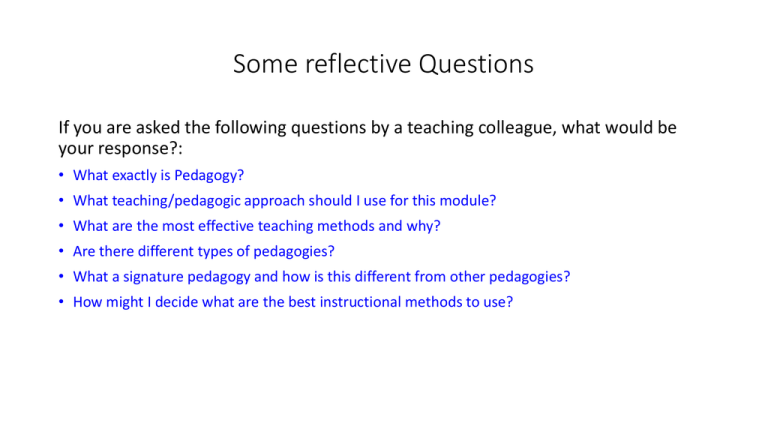
Some reflective Questions If you are asked the following questions by a teaching colleague, what would be your response?: • What exactly is Pedagogy? • What teaching/pedagogic approach should I use for this module? • What are the most effective teaching methods and why? • Are there different types of pedagogies? • What a signature pedagogy and how is this different from other pedagogies? • How might I decide what are the best instructional methods to use? There definitely is an Educational Psychologists Picnic Basket Teaching Styles Learning Experience Differentiated Instruction Signature Pedagogy Pedagogic Approach Teaching Approach Teaching Philosophy Learning Design Instructional Strategy Teaching/Learning Strategy Andragogy Learning Styles Pedagogy Many of these terms are often used interchangeably; some may not even be useful in todays context – we need to have a Best Common Understanding and Language for SP’s context CURRICULUM Educational Philosophy. Aims & Curriculum • Educational Philosophy & Aims (are essentially concerned with the desired outcomes of education; often reflect view s on ‘the good society’, ‘educated person’, ‘citizenship’) • Our Vision and Mission, Holistic Education and Graduate Attributes are very much philosophy and aim orientated, as they reflect valuations about what our students should be like to be productive citizens (in Singapore) • Curriculum is essentially ‘an educational offering’ created to meet desired educational aims at outcome level – (e.g., Competencies, Learning outcomes, Objectives – all similar in meaning): • All curriculum offerings typically involve the following components (Learning Outcomes, Content Knowledge, Instructional Strategy, Assessment , Learning Spaces, Supporting Resources), which are systematically organized to meet the Learning outcomes in the most effective and efficient ways • Curriculum can be framed at a macro level (e.g., secondary school curriculum), programme level (e.g., science curriculum) or micro level (e.g., short course on home safety for domestic helpers in Singapore) • The design of a curriculum often reflects philosophy as noted above – hence a range of Curriculum Models have been developed across a range of educational contexts. However all will have these key components, though the form and emphasis may vary greatly, based on philosophy, aim and context – illustrated in the following slide Broad Curriculum Models: Guiding the Curriculum design • Curriculum models help designers to systematically map out the rationale for the use of particular teaching, learning and assessment approaches • The curriculum is then structured based on the key principles of the model The main curriculum models fall into two broad categories: • Product Models: focus on clear out comes (e.g., Outcomes based, Standards based, Competency based) • Process Models: Focus on the process of learning, types of activities and experiences (e.g., Inquiry-based learning, PBL, CBL) • Our CDIO curriculum Model (this can also be called a framework – which is a term typically used for a large scale curriculum model), combines both a focus on product and process. It also reflects our educational philosophy and aims – captured in our Vison, Mission and Graduate Attributes. Making sense of Pedagogy and related terms: Historically there has been much change and confusion in the use of the term • The term pedagogy is derived from the Greek words paid, meaning “child” and agogus meaning “leader of.” Essentially it refers to the teaching of children. • More recent definitions have dropped the reference to child and applied it more generically to “the principles, practice, or profession of teaching” or “the activities of educating or instructing.” • Pedagogy has also been contrasted with the term andragogy (Knowles (1973), which focuses on the teaching of adult learners. • The better evidence suggests that Andragogy has limited uses – while there are differences its more motivationally and experience level based (e.g., adults have a clear focus on what they want to learn and why: kids are told to learn stuff) than differences in the actual learning process (well after 15 years of age – post cerebral maturation) • Pedagogy has also evoked much debate over the decades in terms of adequate definition. Approaches to pedagogy have gone through various phases, focusing on such aspects as ‘teaching styles’, ‘paradigms of learning’, ‘models and methods of teaching’ and ‘the context of teaching’. As Mortimore (1999) pointed out: “Pedagogy has been seen by many within and outside the teaching profession as a somewhat vague concept” (p.228) • He suggests that pedagogy is most usefully conceived as: “…any conscious activity by one person designed to enhance learning in another” (p.3) A Suggested operational definition of Pedagogy The science and art that informs how we create optimal learning experiences for the students we teach This involves organizing the key curriculum components (e.g., learning outcomes, content knowledge, instructional system, assessment, learning spaces, and supporting resources) based on: Validated knowledge on how human learn best Research on what methods work best, how and in what contexts (e.g., what the best teachers actually do in terms of their human conduct and interactions with learners) NOTE: while there are universal principles here, they must always thoughtfully contextualized to the profile of the learning group and situated context Health Warning: Conflation • A deep read through the literature and surfing the net (“The Cult of the Amateur” – as Andrew Keen wrote) shows massive conflation of these terms: hence we do what? • Some key terms include the following: • Teaching strategy; Instructional strategy; pedagogic strategy, Learning Design • Teaching methods; Instructional methods; teaching techniques and tools Teaching styles, Learning styles (ok you can get rid of these – not valid or useful in the modern context) • Make some thoughtfully choices and agree their coverage and scope – but recognize that some may be used interchangeably Instructional Strategy (Teaching Strategy/Pedagogic Strategy, Learning Design/ Instruction methods, techniques and tools) • This refers to the overall plan for creating the student learning experience to promote the desired outcomes for a learning group. • It typically involves a pedagogically driven selection and combination of Instructional Methods, Learning Activities and Learning Resources. • Instructional methods are, in the broadest sense, teacher directed planned structures for creating a particular type of learning experience, directed towards meeting certain learning outcomes. The main feature of any method is that it provides the ‘how to’ for achieving the acquisition of certain knowledge or skills. • Learning activities are specific performance-based tasks used to engage students actively in the learning process, again with the intention of contributing to the attainment of desired learning outcomes. Activities are usually used in unison with methods, and can sometimes refer to the same thing. For example, cases are considered a method of instruction, but the actual case is an activity in itself. • Learning Resources are essentially anything else beyond specific methods and activities that are used to support the learning process. At a more macro level, this will involve Learning Spaces and all the facilities and equipment necessary for supporting desired learning, e.g., classrooms, laboratories, online facilities, etc., as well as everyday teaching and learning aids such as presentation slides, multimedia and hand-outs) • NOTE: Teaching techniques and Tools (e.g., mnemonics, mind-mapping, thinking tools) are often used interchangeably. I tend to frame them under the umbrella term of resources They are sometimes thrown in with methods or strategies – but then we are back in the conflation problem Example: Unpacking PBL as Method • Teaching Philosophy, Aim & Curriculum (e.g., desired educational purpose and beliefs about learning, curriculum design) • Good thinking and working collaboratively in solving real world problems are key requisites for work and citizenship • Students learning is best attained through focusing on the development of key cognitive processes and learning skills rather than the more formal acquisition of content knowledge (e.g., structured instruction in the traditional forms of knowledge) • The curriculum is progressively structured around key problems that frame the professional field • Using the method as an Instructional Strategy • • • • • There is no absolute way of using PBL , but the following features are typical of how the process of the method is conducted: Presentation of problem as a simulation of professional practice or a ‘real life’ situation Generation of questions and use of thinking skills and tools to explore the problem and plan a course of action that will lead to its solution Collaborative research activity to access and explore information sources in order to build up a knowledge base of relevant resources relating to the problem Presentations of information found, peer teaching and application of the learning to the problem situation Review of the problem in relation to new knowledge and evaluation of the learning process • NOTE: when PBL becomes the main/only pedagogy (e.g., Signature Pedagogy’- such as at RP) the method takes on the characteristics of a full blown educational philosophy . We should be very cautious of this – what is RP doing now? The Basis for Designing Effective Instructional Strategies? • “There are systematic and principled aspects of effective teaching, and there is a base of verifiable evidence of knowledge that supports that work in the sense that it is like engineering or medicine” (Darling-Hammond & Bransford, 2006, p.12) “..it is teachers using particular teaching methods, teachers with high expectations for all students, and teachers who have created positive student-teacher relationships that are more likely to have the above average effects on student achievement” (p.126) (From Visible Learning, John Hattie, 2009) Pedagogic Approach: Evidence-based Practice “It is hard to conceive of a less scientific enterprise among human endeavours. Virtually anything that could be thought up for treatment was tried out at one time or another, and, once tried, lasted decades or even centuries before being given up. It was, in retrospect, the most frivolous and irresponsible kind of experimentation, based on nothing but trial and error, and usually resulting in precisely that sequence” (p.159) The medical profession before the drive for evidence-based practice (Thomas, 1979, p.159) Teaching, if it is to have any real credibility as professional activity, must adopting a similar evidence-based approach to practice Evidence-based practice is consistent with the operational definition of pedagogy outlined in Slide 6 – and constitutes a highly defendable best frame on Pedagogic Approach. Example of how some methods have high effect sizes on Student Attainment (Hattie’s meta-analysis ) No. Influence Mean effect size 2 Feedback Students getting feedback on their work from the teacher or from themselves (self-assessment or from peers or some other sources. Note: some feedback has more effect than others. For example, peer assessment is 0.63 and self-assessment is 0.54 0.81 3 Whole-class interactive teaching (direct instruction) A specific approach to active learning in class, which is highly teacher led, but very active for students. This involves summaries reviews and a range of active learning methods, including questioning 0.81 4 Strategy training Explicit teaching of subject-specific and general study and thinking skills, integrated into the curriculum 0.80 11 Cooperative learning 0.59 Specific teaching methods such as jigsaw that give students responsibility for learning and teaching each other 12 Challenging goals for students Giving students a summary in advance and a purpose for the learning 0.59 Good Pedagogy and ‘Signature Pedagogies’ While we are now in a position to design Instructional Strategies from a strong evidence-base, the choice of what are the most appropriate methods (or combination of methods) depends on a number of key factors (e.g., the types of learning outcomes to be developed, the maturity and prior knowledge of the student group, resource availability) As Bransford (1999) pointed out: “Asking which teaching method/technique is best is analogous to asking what tool is best – a hammer, a screwdriver, a knife, or pliers. In teaching, as in carpentry, the selection of tools depends on the task at hand and the materials one is working with” (p.22) Hence for some programmes, there may be a dominant method (or methods combination), that is most appropriate for structuring the instructional strategy as it reflects what professional do in real work contexts (e.g., case-based learning; studio-based learning). It has become vogue in some quarters to refer to this as ‘Signature Pedagogies’. However, this is always underpinned by good pedagogy (evidence-based) and the creative design and competence of teachers to make it work in practice. Cake Analogy Signature Pedagogies Pedagogic Literacy
